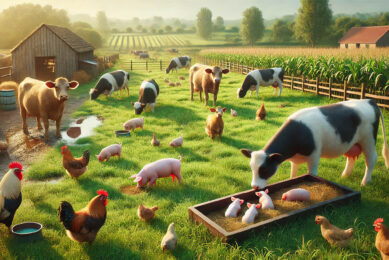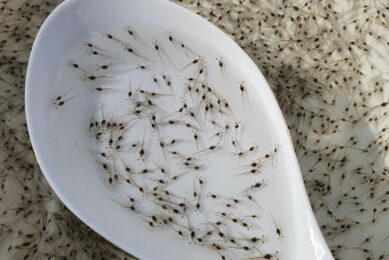Impact of mycotoxins on gut health

Mycotoxins in animal feed represent a very real threat to the health of the animal. Even low amounts of mycotoxins can have a negative effect on gut health. This can leave the animal more susceptible to infectious diseases.
Intestinal health is of major importance for maximising the health, welfare, and performance of production animals. Livestock has traditionally been selected for optimal feed conversion and maximal body weight gain. However, gut health in production animals is constantly challenged throughout the entire life of the animal by exogenous and endogenous stressors. Among the most important exogenous stressors and safety risks for the future feed industry and security of feed supply chain are mycotoxins.
Mycotoxins are secondary metabolites produced by toxigenic fungal species present on a multitude of crops. Mycotoxin contamination appears all through the life and process cycle of crops starting from the pre-harvest, harvest, and post-harvest, as well as the process stage.
The dynamic crosstalk between intestinal epithelial cells, microbiota, local immune cells, and nutrition represents one of the major regulatory mechanisms to maintain intestinal homeostasis. Dysregulation of this homeostasis can result in leaky gut, intestinal inflammation, and dysbiosis. Ingestion of even low to moderate levels of mycotoxins is disturbing this intestinal homeostasis. Understanding the different types of interactions of mycotoxins with the gastro-intestinal environment will be of major importance for future risk assessment and the organisation of efficient mycotoxin mitigation strategies.
Mycotoxins and leaky gut
The intestinal epithelium is a single layer of cells lining the gut lumen that acts as a selective barrier, allowing the absorption of nutrients and water from the intestinal lumen into the blood circulation. It also constitutes the largest and most important barrier to prevent the passage of harmful substances present in the gastro-intestinal tract, including foreign antigens, microorganisms, and their toxins. Mycotoxins damage the intestinal barrier and induce leaky gut, through the modulation of intestinal epithelial integrity and epithelial cell renewal and repair. By measuring the transepithelial electrical resistance (TEER) and intestinal mRNA expression of genes encoding tight junction proteins, several in vitro and ex vivo studies indicate that mycotoxins such as deoxynivalenol (DON) and fumonisins (FUM) are able to increase the permeability of the intestinal epithelial layer of humans and animals e.g. pigs and poultry. Also, the viability and proliferation of animal and human intestinal epithelial cells can be negatively affected by mycotoxins.
Besides the negative impact of mycotoxins on the intestinal epithelial cells, these toxins have also an impact on the other elements of the intestinal barrier, such as the mucus layer, secretion of antimicrobial peptides, chemokines and cytokines, and oxidative stress. Exposure to the mycotoxins DON and/or zearalenone (ZEN) decreased the number of goblet cells in the small and large intestine of pigs, which are of major importance for the mucus secretion. Besides, sub-toxic doses of DON were found to reduce intestinal mucin production through a specific decrease in levels of mRNA encoding for the membrane-associated mucins in pigs and poultry. Several mycotoxins are also able to modulate the production of intestinal inflammatory cytokines. For example, intestinal exposure to DON induced a pro-inflammatory response with an increased expression of interleukin (IL)-1α, IL-1β, IL-8, and tumour necrosis factor (TNF)-α.
Interaction between mycotoxins and gut microbiota
The gastro-intestinal tract hosts a dynamic microbial population that forms a complex ecosystem and has a symbiotic relationship with the animal host. The intestinal microbiota contributes to several physiological functions such as protective, structural and metabolic functions, regulation of the host homeostasis by contributing to optimal digestion and absorption, regulation of energy metabolism, prevention of mucosal infections and modulation of the immune system. Disturbances in the gut microbial ecosystems during the rearing of livestock animals can dramatically increase risk of disease. Few studies have demonstrated an impact of mycotoxin exposure on the gut microbiota composition and diversity in humans and different animal species. It has been observed that the abundance of different bacterial families / genera such as Lachnospiraceae, Ruminococcaceae, Lactospiraceae, Faecalibacterium, Clostridiaceae Enterobacteriaceae, and Roseburia can be affected by mycotoxin exposure. These shifts in the intestinal microbiota composition might be associated with the impact of the mycotoxins on the digestive physiology, enterocyte viability, and mucus production.
Enhanced susceptibility for infectious diseases
The negative impact of mycotoxins on the gastro-intestinal physiology and immune system might also enhance the animal susceptibility to common infectious diseases in animal production, such as increasing Salmonella Typhimurium issues in pigs by promoting bacterial invasion, trans-intestinal epithelial passage, and the uptake by alveolar macrophages. Additionally, feeding pigeons a DON contaminated diet resulted in an increased percentage of pigeons shedding Salmonella compared to birds fed control diet, 87% versus 74 %, respectively. Furthermore, it was demonstrated that feeding a DON or FUM contaminated diet is a predisposing factor for the development of Clostridium perfringens induced necrotic enteritis in broiler chickens. This coincides with the above-mentioned negative effects on selected components of the intestinal barrier of the chicken host, i.e. villus height, tight junctions, mucus, oxidative stress, and microbiota homeostasis. Recently, it was also demonstrated that DON also influences the infection profile of Campylobacter jejuni in broiler chickens. The co-exposure of DON in poultry feed and C. jejuni resulted in an enhanced C. jejuni colonisation in the gut as well as an increase in gut permeability.
Susceptibility to diseases
In conclusion, the omnipresence of mycotoxins in feed represents an important threat for animal health. Even low to moderate amounts of mycotoxins have a negative impact on gut health by inducing leaky gut, intestinal inflammation, and influencing the intestinal microbiota composition. Consequently, the mycotoxin-induced intestinal metabolic, physiologic and immunologic disturbances mean animals are more susceptible to infectious diseases.
References are available on request.






